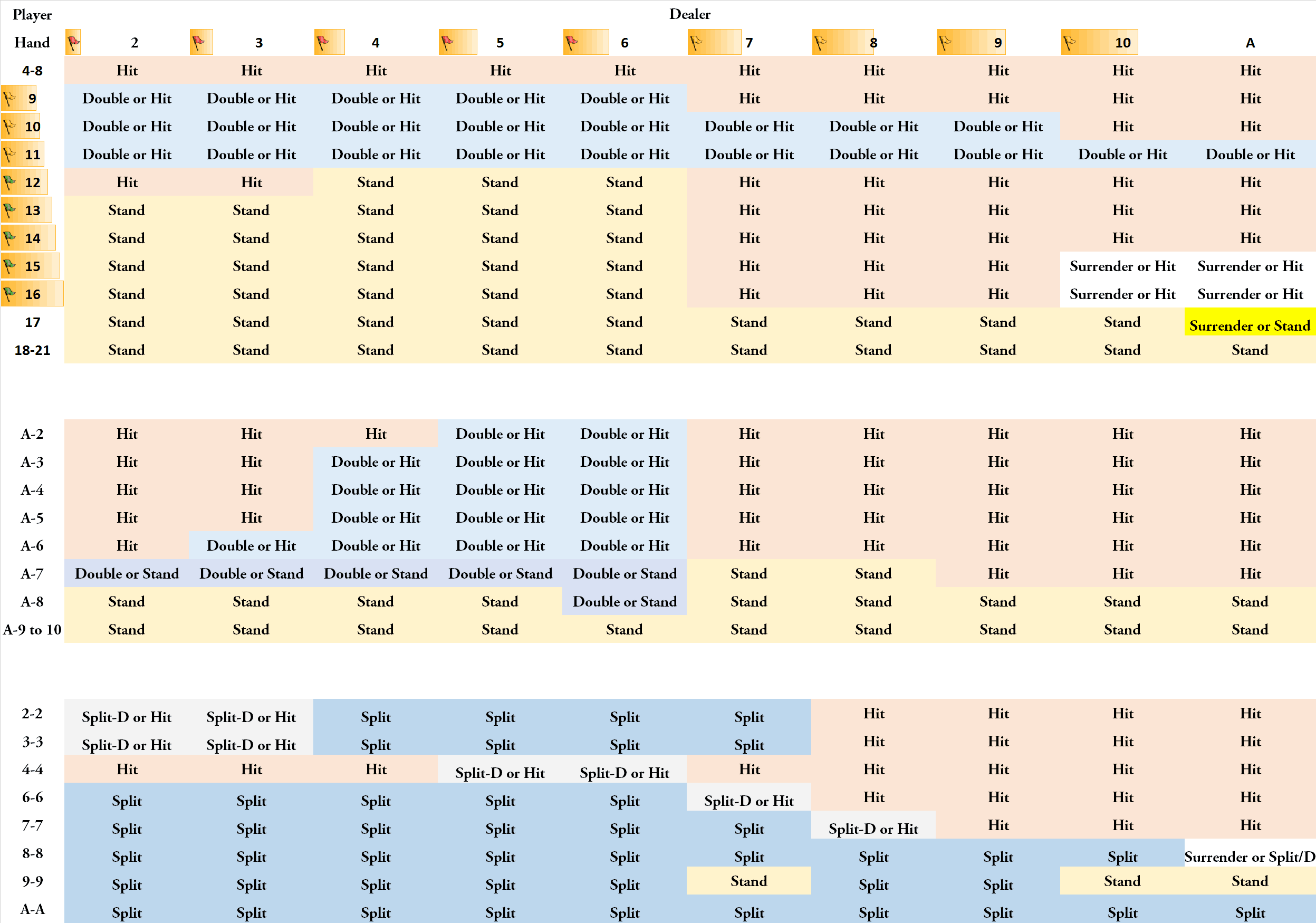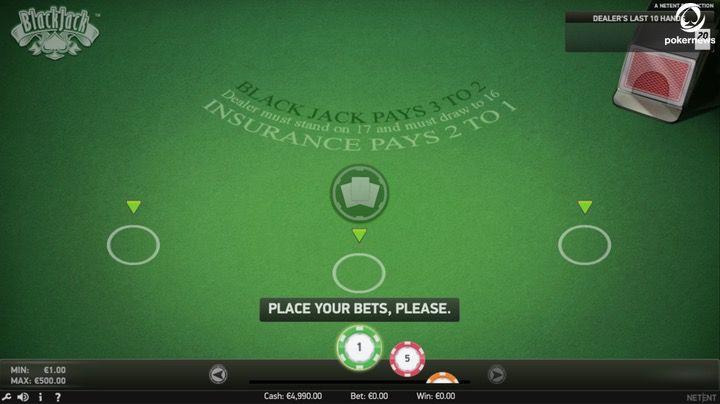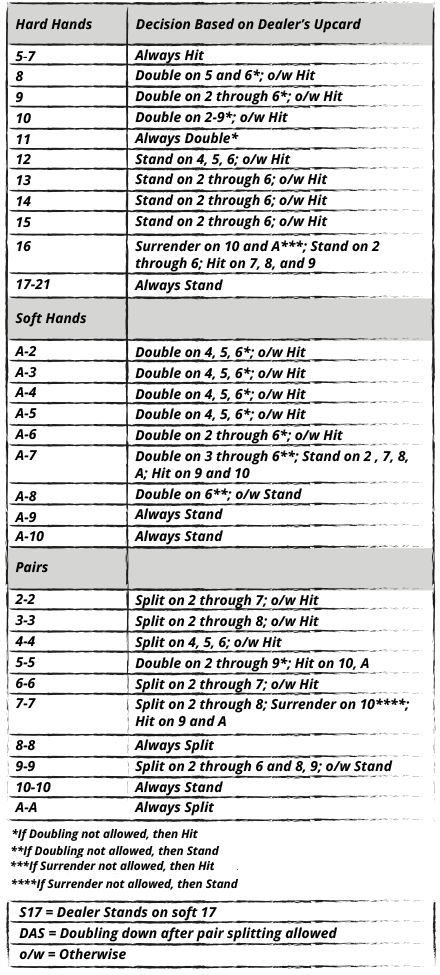Single Deck Blackjack Strategy
Card counting is an advanced technique that enables blackjack players to identify the instances when the odds shift in their favor. When this happens, the player would raise their bets. Conversely, when the player is at a disadvantage, they would bet small or completely refrain from betting. It is this variation in bet size that enables card counters to beat the game of blackjack.
- Single Deck Basic Strategy
- Single Deck Blackjack Strategy Card
- Double Deck Blackjack Guide
- Is Single Deck Blackjack Better
In single-deck games, we double against the Ace, too. To get the most out of the single-deck game, we make a number of little strategy changes from basic strategy for multiple-deck games: Single-deck variations for hard totals. Double down on 11 against all dealer up. 4-Deck to 8-Deck Blackjack Strategy Introduction. To use the basic strategy, look up your hand along the left vertical edge and the dealer's up card along the top. In both cases an A stands for ace. From top to bottom are the hard totals, soft totals, and splittable hands. There are two charts depending on whether the dealer hits or stands on. EXAMPLES OF HOW TO USE THE BLACKJACK BASIC STRATEGY. Single-deck game with hard 17, you hold 16, dealer’s upcard is a 10. You should surrender. Double-deck game with soft 17, you hold 15, dealer’s upcard is an ace. You should hit (surrender only against dealer’s 10). Six-deck game with soft 17, you hold 16, dealer’s upcard is a 9. Here’s one recommended simplified strategy for doubling down in Single Deck Blackjack: 1. Double with Hard 9 or Soft 16-18 if the Dealer shows a low card (2-6).
- Bonus$300
- Bonus$300
- Bonus⋆80 Free Spins
Keeping track of the cards through counting is possible in both single-deck and multiple-deck blackjack variations. Single-deck games can be very profitable (provided that they offer decent table conditions) because the effect of removing individual cards from a single deck is more significant.
Counting single-deck games requires a different approach you are recommended to acquaint yourself with even if you play mostly shoe blackjack. Stick with us for further clarification on what this approach is and how you can improve your speed and accuracy while counting single-deck blackjack games.

How Counting Works in Single-Deck Blackjack
The method of counting is slightly different here due to the fact single-deck players receive their first two cards face-down. In comparison, those who play shoe blackjack have all their starting hands dealt face-up, a peculiarity which renders it easier for counters to keep an accurate track of the cards.
It would be difficult in the beginning, especially if you have already grown accustomed to counting shoe games. The main principle remains the same, however. You again add or subtract the value of each visible card that is dealt. On the basis of this, you establish a running count to help you with accurate bet sizing. The trouble is the two starting cards of other players are dealt facing-down in single-deck games so they are not immediately visible for you to adjust your running count with.
There will be situations in which things get a little hectic. For example, suppose the dealer gets a blackjack and all players muck their hands face-up. You need to be able to count all visible cards very quickly before the next round of play commences. This is something that requires a good deal of practice.
Single Deck Basic Strategy
When a player hits their two-card total, their hit cards are dealt face-up so you can easily see them. After the reshuffle, you start by counting the first cards that you can actually see, those in your starting hand and the dealer’s exposed card.
How Counting Works in Single-Deck Blackjack – Additional TipsProvided that you are not the first person to act, you should count the hit cards of the people who have drawn before you. When another player doubles, they are also required to reveal their starting hand so you should count those two cards as well. However, the double card itself is again dealt facing down so you will not be able to add its value to your running count just yet.
Whenever a player decides to split, they are also required to reveal the two cards the pair consists of. You count them along with the hit cards drawn to each card of the pair. When a player decides to stay on their hand, they must tuck their two cards face-down underneath their chips in the betting circle. Obviously, you will have to wait for the end of the round to see and count those cards.
If someone busts, he or she mucks their starting hand face-up – add those cards to your running count as well. The dealer is the last person to act at the table. When their turn comes, be sure to count both their hole card and the additional cards they draw, if any.
This is the order in which you count the cards at the single-deck table. Keep in mind that when settling the bets, the dealer starts with the player in the third-base spot turning over all hole cards including those on double downs. To prevent mistakes, you need to count those hole cards as they are exposed. Otherwise, you risk counting some of the cards twice which messes up your running count.
This may seem a bit overwhelming at first but you will inevitably get used to it when you watch actual single-deck games in progress. In the beginning, you can just stand by and watch others play or practice at home by asking a more experienced friend to deal you the cards and settle the bets for you.
Tips on Improving Your Speed and Accuracy
In order to be a successful counter in single-deck blackjack, you must develop both speed and accuracy. You can start your training by shuffling two decks together and counting them down. You can test your accuracy by remove three of the cards.
After you have developed some speed and are able to count the two decks down in less than forty seconds, you can proceed by practicing with six decks shuffled together. Divide the cards into six separate stacks and try to count them down as quickly as you can. You should practice this way until you develop the ability to count the six decks down in less than two minutes.
The purpose of practicing with multiple decks is to help you maintain an accurate count for prolonged periods of time. This way, you also grow accustomed to experiencing more dramatic swings in the count. You will rarely witness running counts of +10 or -10 in single-deck blackjack but these are not such a rarity in shoe games. You should know how to approach those high positive and negative counts in both types of games.

Another good idea is to try and mimic the hectic casino environment by practicing with a lot of distractions around you. If you get interrupted while counting the cards, you can try repeating the running count in your mind. The real sign of progress comes when you develop the ability to converse with people at the table without losing your running count. The only way to achieve this is through practice.
Moving Your Bets with the Running Count in Single-Deck Blackjack
Regardless of the number of decks you play against, you gain an advantage over the house by sizing your bets in accordance with the count. The general rule of thumb for card counters is to up their action when the composition of the remaining deck/shoe is favorable (i.e. when it is rich in high cards) and reduce their bets or altogether refrain from betting on negative counts when the odds shift in favor of the casino.
Sizing your bets in accordance with the count is quite easy in single-deck blackjack. In order to do it successfully, you need to gain a sufficient understanding of the shuffling procedures single-deck dealers are instructed to follow.
The single-deck dealers in many landbased casinos abide by the so-called “rule of 6” which dictates the deck should be reshuffled when the sum total of the number of the players at the table and the number of rounds played is equal to 6.
Moving Your Bets with the Running Count in Single-Deck Blackjack – Additional TipsJust to give you an example, suppose you are sitting at the single-deck table with two more players – the dealer will reshuffle the deck after three rounds because 3 rounds plus 3 players equals 6. If five players are sitting at the table, the dealer will reshuffle the cards after a single round of play. It becomes obvious the more crowded a table is, the more frequent the reshuffles will be.
Single Deck Blackjack Strategy Card
The bottom line is single-deck players do not get the chance to go through that many rounds before a reshuffle takes place. This frequent reshuffling is quite detrimental for card counters because the dealer often ends up shuffling their advantage on high positive counts away.
Note that not all landbased casinos abide by the “rule of 6”. Some single-deck dealers follow the “rule of 7” which is better for advantage players. Others perform more frequent reshuffles under the “rule of 5” which naturally is worse for the counter. Either way, the only way for you to figure out which shuffling rule applies would be to stand by and observe a game in progress.
Double Deck Blackjack Guide
The thing is most regular gamblers prefer to either flat bet or to increase their bets dramatically following a win. For the purpose of avoiding detection, you are advised to refrain from spreading your bets very aggressively.

Some experts recommend a timid 1-to-4 bet spread for single-deck games. You bet one unit when you have negative, neutral and +1 running counts and raise your wagers incrementally as the count increases.
The higher positive count you reach, the larger the edge you have and the more you should wager. Respectively, when the running count reaches +2, you should bet 2 base units; when it escalates to +3, you should bet 3 units; finally, when it hits +4 or above, you continue flat betting 4 units until the count drops again to justify a bet decrease.
This is just an example of a bet ramp you can use in a single-deck game of blackjack. You can choose another bet spread if you wish. Just remember to increase your action when you have the advantage and decrease it when at a disadvantage.
Is Counting Single-Deck Blackjack Worthwhile?
Single-deck blackjack is the best variation of the game to play if you know how to count cards. The fewer the number of decks in play, the lower the house edge. Players generally tend to enjoy more blackjacks and more successful doubles/splits when a single deck of cards is used.
The trouble is casino operators themselves are aware single-deck blackjack is beatable so they change the rules with more unfavorable ones to hinder card counters. If you are unable to find a single-deck table with half-decent rules, you better not bother. Many single-deck games offer payouts of 6 to 5 for blackjack. These are the tables you need to avoid because the reduction in the blackjack payout increases the casino advantage by 1.40%. It is impossible to beat one such game even if you are a very skilled card counter.
Some of the other rules may also be unfavorable. Dealers at single-deck tables are often required to hit soft 17 which works to your disadvantage. Some casinos would restrict players to doubling only on specific two-card totals like 9, 10, and 11. This significantly cuts down the profits you can extract from the game. The opportunities for splitting and re-splitting may also be limited which again leads to a profit decrease for the player.
To wrap things up, you should never settle for a game with subpar playing conditions just because it plays with a single deck. A decent single-deck game to count is one where the dealer gives you are least three rounds before they reshuffle and pays your blackjacks at the standard rate of 3 to 2.
US Players and Credit Card, BitCoin Deposits Accepted!

The following strategy charts are designed for single deck blackjack. Before you begin using these charts, make sure that you are playing in a single deck game. These charts slightly vary for optimum performance on a game to game basis.
Action: H = HitS = StandD = Double P = Split
Hard Totals:
Is Single Deck Blackjack Better
| Hard Totals | 2 | 3 | 4 | 5 | 6 | 7 | 8 | 9 | T | A |
|---|---|---|---|---|---|---|---|---|---|---|
| 8 | H | H | H | D | D | H | H | H | H | H |
| 9 | D | D | D | D | D | H | H | H | H | H |
| 10 | D | D | D | D | D | D | D | D | H | H |
| 11 | D | D | D | D | D | D | D | D | D | D |
| 12 | H | H | S | S | S | H | H | H | H | H |
| 13 | S | S | S | S | S | H | H | H | H | H |
| 14 | S | S | S | S | S | H | H | H | H | H |
| 15 | S | S | S | S | S | H | H | H | H | H |
| 16 | S | S | S | S | S | H | H | H | H | H |
| 17-20 | S | S | S | S | S | S | S | S | S | S |

Soft Totals:
| Soft Totals | 2 | 3 | 4 | 5 | 6 | 7 | 8 | 9 | T | A |
|---|---|---|---|---|---|---|---|---|---|---|
| A 2 | H | H | D | D | D | H | H | H | H | H |
| A 3 | H | H | D | D | D | H | H | H | H | H |
| A 4 | H | H | D | D | D | H | H | H | H | H |
| A 5 | H | H | D | D | D | H | H | H | H | H |
| A 6 | D | D | D | D | D | H | H | H | H | H |
| A 7 | S | D | D | D | D | S | S | H | H | H |
| A 8 | S | S | S | S | D | S | S | S | S | S |
| A 9 | S | S | S | S | S | S | S | S | S | S |
Pair Splitting:
| Pairs | 2 | 3 | 4 | 5 | 6 | 7 | 8 | 9 | T | A |
|---|---|---|---|---|---|---|---|---|---|---|
| 2 2 | H | P | P | P | P | P | H | H | H | H |
| 3 3 | H | P | P | P | P | P | H | H | H | H |
| 4 4 | H | H | H | D | D | H | H | H | H | H |
| 5 5 | D | D | D | D | D | D | D | D | H | H |
| 6 6 | P | P | P | P | P | H | H | H | H | H |
| 7 7 | P | P | P | P | P | P | H | H | H | H |
| 8 8 | P | P | P | P | P | P | P | P | S | P |
| 9 9 | P | P | P | P | P | S | P | P | S | S |
| 10's | S | S | S | S | S | S | S | S | S | S |
| A's | P | P | P | P | P | P | P | P | P | P |
Blackjack Betting Systems:
Some Online Casinos:
US Players and Credit Card, BitCoin Deposits Accepted!